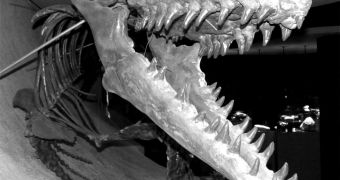While land-based dinosaurs were competing for dominance on the surface of the Earth, an equally-powerful war was being fought in the planet's oceans, where numerous voracious species lived. In time, the mosasaurs became the ultimate predators, and scientists now analyze their rise in careful detail.
According to investigators, when the creatures first entered the water, they were not at all equipped to handle the harsh demands of the environments. Their limbs were still adapted to walking on land, while their swimming abilities were limited at best.
Yet, within the span of about 27 million years, they evolved to a point where they had a sleek, streamlined body, and the ability to outmaneuver most other predators in the seas. In short, mosasaurs became the Tyrannosaurus Rex of the seas.
In the new study, experts look at the evolutionary background for this strong adaptation. The work was made even more interesting by the fact that some evidence appear to suggest mosasaurs were capable of hunting and eating the large ginsu sharks they shared the oceans with.
In order to conduct the investigation, experts used fossils from four species of the creature, together with an analysis of existing species such as sea snakes, lizards and sharks. The latter helped by providing experts with the necessary data on soft tissue.
Experts used these studies to fill in the gaps about how the bodies of mosasaurs looked like. It's highly doubtful that science will even uncovered soft tissue fossils from this species, and this is why experts made do with what they had, LiveScience reports.
Lund University paleontologist and lead study researcher Johan Lindgren says that his group used fossils ranging from the small Dallasaurus to the larger Plotosaurus. While the former was built for life on land, the latter was the last stage of evolution, featuring a dolphin like body and other adaptations.
The team leader says that the way these animals evolve – by developing channels on their scales to direct the flow of water while submerged, for example – was critical towards their rise to dominance during the late Cretaceous period.
They became the top of the food chain at the time, before the K-T extinction event, some 65 million years ago. During the catastrophic event, all mosasaurs disappeared, alongside a very high percentage of all complex life on Earth.
In the Summer 2011 issue of the journal Paleobiology, experts argue that this group of species may have led to the extinction of other animals.
Mike Everhart, the adjunct curator of paleontology at the Sternberg Museum of Natural History in Hays, Kansas, says that the 56-foot (17-meter) mosasaurs may have decimated the 22-foot (7- meter) ginsu shark, which had until then ruled supreme.

 14 DAY TRIAL //
14 DAY TRIAL //